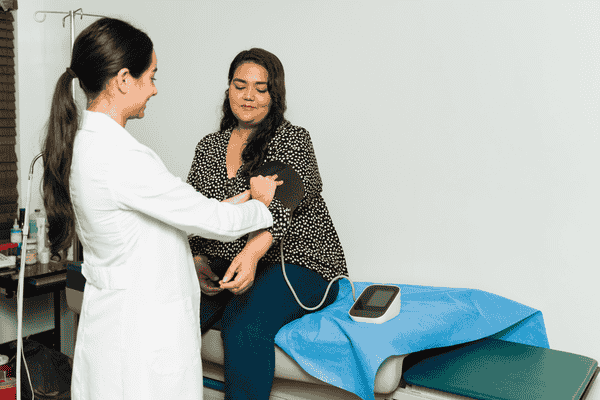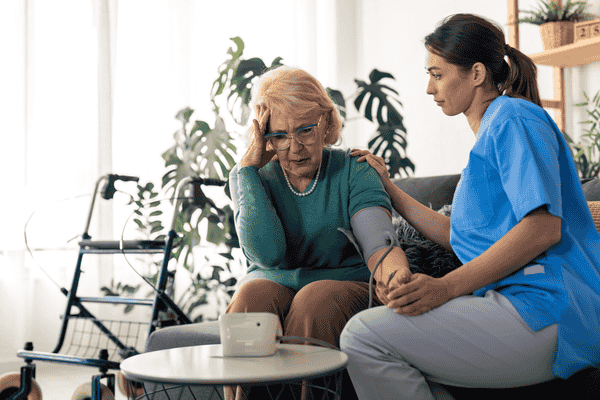In a quiet neighborhood, the home of Sarah and her mother, Margaret, was once filled with warmth and laughter. Margaret, the matriarch, was known for her sharp mind and boundless energy. She was the kind of woman who never forgot a birthday, always had a solution to every problem, and could light up a room with her smile. But as the years went by, something began to change. The sparkle in Margaret’s eyes dimmed, and she started to forget little things—first, where she placed her keys, then more significant details, like the names of her grandchildren. The diagnosis of Alzheimer’s disease came like a dark cloud, casting a long shadow over their lives.
The Emotional Journey of a Caregiver
For Sarah, the realization that her mother’s memory was slipping away was heartbreaking. At first, she clung to denial, hoping that the forgetfulness was just a phase. But as Margaret’s condition worsened, Sarah found herself thrust into the role of a full-time caregiver. The emotional toll was overwhelming. Sarah experienced waves of grief, mourning the gradual loss of the vibrant mother she once knew. There were moments of anger, too—anger at the disease, at the situation, and sometimes, even at her mother, though she knew it wasn’t her fault.
Caregiving for a loved one with Alzheimer’s is a journey that requires immense emotional resilience. It’s not just the physical demands of the role that are taxing; it’s the emotional burden of watching someone you love fade away. Many caregivers, like Sarah, struggle with feelings of guilt, frustration, and helplessness. It’s important to recognize these emotions and understand that they are a natural part of the caregiving experience. Seeking emotional support through counseling, support groups, or even talking with friends and family can make a significant difference in managing these feelings.
Building a Robust Support Network
Sarah quickly realized that she couldn’t do it all alone. The responsibilities of caregiving—from managing her mother’s daily needs to handling medical appointments—were too much for one person to bear. She reached out to her local community and discovered a network of support that became her lifeline.
Joining an Alzheimer’s support group was one of the most crucial steps Sarah took. In these meetings, she found others who were going through similar experiences. They shared stories, offered practical advice, and provided emotional comfort. Through this group, Sarah learned about the importance of not only caring for her mother but also caring for herself. She discovered that asking for help wasn’t a sign of weakness but a necessary part of being an effective caregiver.
Beyond the support group, Sarah also tapped into her circle of friends and family. She organized a caregiving schedule that allowed her to take regular breaks. Her brother, who lived in another state, arranged to visit once a month to give Sarah some much-needed respite. Neighbors volunteered to run errands or spend time with Margaret so Sarah could have a few hours to herself. This network of support was essential in preventing caregiver burnout, a common issue faced by many in Sarah’s position.
Creating a Dementia Care Plan
One of the most daunting tasks Sarah faced was developing a dementia care plan for her mother. Alzheimer’s disease is unpredictable, and Margaret’s needs were constantly changing. To navigate these complexities, Sarah knew she needed a plan that was both comprehensive and flexible.
The first step was to assess her mother’s current abilities and anticipate how they might change over time. She worked closely with Margaret’s doctors to understand the progression of the disease and what to expect in the coming months and years. Together, they developed a care plan that included medical care, daily routines, and safety measures.
Anticipating Changing Needs
As Alzheimer’s progresses, the needs of the individual evolve. In the early stages, Margaret was still relatively independent, requiring only occasional reminders and assistance with complex tasks. However, as the disease advanced, her ability to perform daily activities diminished. Sarah learned the importance of anticipating these changes to avoid crises.
For instance, when Margaret began having difficulty recognizing familiar faces, Sarah prepared by creating a memory book filled with labeled photos of family members and friends. She also started incorporating more structured routines into their day, which helped reduce Margaret’s anxiety and confusion.
Setting Realistic Goals
One of the lessons Sarah learned early on was the importance of setting realistic goals. Caregiving for someone with Alzheimer’s isn’t about finding a cure or reversing the disease; it’s about maintaining the highest possible quality of life for both the caregiver and the person with dementia.
Sarah’s goals focused on keeping her mother safe, comfortable, and engaged. She prioritized activities that Margaret could still enjoy, like listening to music or gardening, even if those activities looked different than they used to. By setting achievable goals, Sarah was able to manage her expectations and avoid the frustration that comes with trying to accomplish the impossible.
Coordinating Care and Support
Sarah quickly realized that caregiving is a team effort. Coordinating care between family members, healthcare professionals, and support services was essential in ensuring Margaret received the best possible care. This meant regular communication with doctors, scheduling home health visits, and working with a geriatric care manager to explore long-term care options.
She also learned the value of having a backup plan. On days when Sarah was overwhelmed or unable to provide care, she had a list of trusted friends and family members who could step in. This coordination ensured that Margaret was never left without the care she needed, even during unexpected situations.
Identifying Resources and Support
Navigating the world of Alzheimer’s care can be overwhelming, especially when it comes to finding the right resources. Sarah spent countless hours researching support services, from in-home care options to financial assistance programs. She found that local Alzheimer’s organizations were invaluable in providing information and connecting her with resources.
Through her research, Sarah discovered respite care services, which allowed her to take short breaks while ensuring her mother was well cared for. She also learned about adult day programs that provided social interaction and activities for Margaret, giving Sarah time to focus on her own needs or simply rest.
Creating a Safe and Supportive Environment
As Alzheimer’s progressed, safety became a major concern. Margaret, once meticulous in her habits, began to exhibit behaviors that put her at risk—leaving the stove on, wandering outside at night, or forgetting to lock the door. Sarah knew that creating a safe environment was paramount to her mother’s well-being.
Reducing Clutter and Hazards
Sarah started by decluttering the house. She removed unnecessary items and rearranged furniture to create clear pathways, reducing the risk of falls. Rugs were secured or removed, and all tripping hazards were addressed. She also installed handrails and grab bars in key areas like the bathroom and stairs, making it easier for Margaret to navigate the house safely.
Implementing Safety Features
To address the risk of wandering, Sarah installed door alarms and placed safety locks on cabinets containing hazardous items, such as cleaning supplies and medications. She also made sure that all electrical outlets were covered and that sharp objects were stored out of reach.
Enhancing Lighting
Proper lighting became crucial as Margaret’s vision and spatial awareness declined. Sarah installed brighter lights in dim areas and added nightlights in the hallway and bathroom to prevent accidents during nighttime trips. These small changes made a big difference in reducing Margaret’s anxiety and confusion, especially in the evenings when symptoms often worsened.
Utilizing Visual Cues
Visual cues were another strategy Sarah used to help Margaret maintain a sense of independence. She labeled drawers, cabinets, and rooms with pictures or simple words to assist with recognition. For example, she placed a picture of a bed on the bedroom door and labeled the kitchen cabinets with images of dishes and utensils. These cues helped Margaret find what she needed without becoming frustrated or overwhelmed.
Establishing Routines
Routine became a cornerstone of Margaret’s care. Sarah established a daily schedule that included regular meal times, exercise, and quiet activities. This routine provided structure and predictability, which helped reduce Margaret’s anxiety and confusion. Sarah also made sure to include activities that Margaret enjoyed and could still participate in, like gardening, listening to music, or looking through old photo albums.
Promoting Independence
Despite the challenges, Sarah was determined to help her mother maintain as much independence as possible. She adapted the environment to make daily tasks easier for Margaret, such as placing easy-to-use utensils in the kitchen and providing clothing with simple fastenings. By encouraging Margaret to continue performing tasks she could still manage, Sarah helped preserve her mother’s dignity and self-esteem.
Emotional Support and Resilience
Caregiving is often described as a marathon, not a sprint. Sarah learned this the hard way as she faced the emotional rollercoaster of caring for her mother. The weight of responsibility, coupled with the grief of watching her mother decline, sometimes felt unbearable. But Sarah also discovered that resilience could be built, brick by brick, through small acts of self-care and seeking help when needed.
Mindfulness and Self-Care
Mindfulness practices became a sanctuary for Sarah. She found peace in short moments of meditation, deep breathing exercises, and simply being present. These practices helped her manage stress and maintain a sense of calm, even on the most challenging days.
Counseling and Emotional Support
Realizing she needed professional support, Sarah sought counseling. Through therapy, she learned coping strategies to deal with the complex emotions of caregiving. Counseling also provided a space for Sarah to express her feelings of grief, frustration, and guilt without fear of judgment. This emotional support was vital in helping her maintain her own mental health while caring for her mother.
Finding Joy in Small Moments
Despite the challenges, Sarah learned to find joy in small moments—holding her mother’s hand during a quiet afternoon, hearing her hum a familiar tune, or watching her face light up at the sight of a blooming flower in the garden. These moments reminded Sarah that while Alzheimer’s had taken much from them, it hadn’t taken everything. The love between them was still strong, even if words and memories sometimes failed.
A Future of Hope
As Margaret’s condition progressed, Sarah knew the day would come when her mother would need more care than she could provide at home. The decision to move Margaret into a memory care facility was heart-wrenching, but Sarah made it with the confidence that she had done everything she could to ensure her mother’s safety and well-being.
Transitioning to Memory Care
The transition to memory care was a challenging time for both Sarah and Margaret. Sarah carefully selected a facility that specialized in Alzheimer’s care, with staff trained to provide the compassionate and individualized support her mother needed. She worked closely with the facility to ensure that Margaret’s care plan was followed and that she continued to engage in activities she enjoyed.
To ease the transition, Sarah brought familiar items from home, like Margaret’s favorite blanket and family photos, to decorate her new room. She visited frequently, maintaining a presence in her mother’s life and reassuring her that she was still loved and cared for.
Advocacy and Community Engagement
In time, Sarah channeled her experience into advocacy. She began volunteering with local Alzheimer’s organizations, sharing her story and helping other families navigate the challenges of caregiving. Her advocacy work not only raised awareness about Alzheimer’s but also provided her with a sense of purpose and fulfillment.
Through speaking engagements, Sarah educated others about the importance of early diagnosis, the challenges of caregiving, and the need for more support services. Her efforts contributed to building a more compassionate community where caregivers could find the resources and support they needed.
Conclusion
Supporting a loved one with Alzheimer’s or dementia is an arduous journey, filled with moments of heartbreak and moments of profound love. Sarah’s story is a testament to the resilience of caregivers and the power of community, planning, and self-care in navigating the challenges of memory care.
As you embark on or continue your caregiving journey, remember that you are not alone. There are resources, strategies, and communities ready to support you every step of the way. By empowering yourself with knowledge, building a robust support network, and taking care of your own well-being, you can provide the best possible care for your loved one.
Caregiving is an act of love that can sometimes feel overwhelming, but it’s also an opportunity to create meaningful connections, even in the face of adversity. Together, with the right strategies and support, caregivers can find strength and hope in even the most challenging times.














Keep up the superb work, I read few content on this website and I think that your web blog is rattling interesting and contains bands of great information.
Saved as a favorite, I really like your blog!
Oh my goodness! an amazing article dude. Thank you Nevertheless I am experiencing issue with ur rss . Don’t know why Unable to subscribe to it. Is there anyone getting similar rss problem? Anybody who is aware of kindly respond. Thnkx
Today, I went to the beach front with my children. I found a sea shell and gave it to my 4 year old daughter and said “You can hear the ocean if you put this to your ear.” She placed the shell to her ear and screamed. There was a hermit crab inside and it pinched her ear. She never wants to go back! LoL I know this is completely off topic but I had to tell someone!
Dead indited written content, Really enjoyed reading.
I like what you guys are up too. Such clever work and reporting! Keep up the superb works guys I’ve incorporated you guys to my blogroll. I think it’ll improve the value of my website 🙂
F*ckin’ amazing issues here. I am very satisfied to see your post. Thank you so much and i am looking forward to touch you. Will you kindly drop me a mail?
Excellent read, I just passed this onto a colleague who was doing a little research on that. And he actually bought me lunch because I found it for him smile Therefore let me rephrase that: Thank you for lunch! “It is impossible to underrate human intelligence–beginning with one’s own.” by Henry Adams.
Thank you for your own labor on this site. My mom takes pleasure in conducting investigation and it is obvious why. My partner and i notice all regarding the lively manner you convey helpful tips and hints by means of your web site and even attract contribution from other people about this idea plus our princess is really studying a whole lot. Take advantage of the rest of the new year. Your doing a fantastic job.